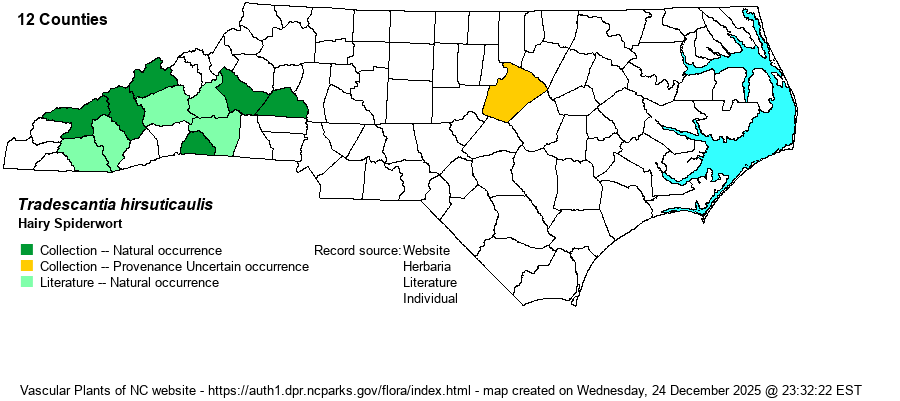| Author | Small | |
| Distribution | Found sparingly in the southwestern Piedmont and southern half of the Mountains; ranges north to Madison County and Catawba County. There are Wake County specimens from Lake Crabtree County Park, but the locations there are likely of escaped populations.
This Southern species occurs from western NC to OK, and south to southern GA and LA. It apparently has not been recorded from FL, and it does not range northward into VA or KY. | |
| Abundance | Rare in both the Piedmont and Mountain part of the range; likely not native eastward of Catawba County. This is a Watch List species as identified by the NCNHP. | |
| Habitat | This is the only Tradescantia in NC that prefers dry and rocky habitats as opposed to mesic or rich ones. It is usually found in dry, open rocky woods, around rock outcrops, and bluffs. In some places it is found on high pH soils, but most sites in NC appear to be on acidic soils. | |
| Phenology | Blooms mainly in April and May, rarely to June; it fruits quickly after flowering. | |
| Identification | This is a fairly standard spiderwort, as it grows to about 1.5 feet tall. It has scattered and narrow leaves along the stem, growing to about 6 inches long but mainly about 1/3-inch wide. Most others in the genus also feature these characters, but T. hirsuticaulis has noticeably hirsute (hairy) leaves and the stem is hairy, as well. At the top of the stem is a cluster of several flowers, usually just one or two blooming at a time, with three wide violet-blue petals. The spread flower is about 1 inch across, and is somewhat triangular in shape (with rounded corners). In this species, the sepals have some hairs and also glands, such that it is a bit sticky to the touch. This species is rare enough in the state that you are not likely to simply stumble onto a population. Most populations are well removed from roads, as well, so that to see it you likely will need to hike around rock outcrops and dry ridges to even have a chance to see it. | |
| Taxonomic Comments | None
| |
| Other Common Name(s) | Hairystem Spiderwort | |
| State Rank | S2 | |
| Global Rank | G5 | |
| State Status | W7 | |
| US Status | | |
| USACE-agcp | | |
| USACE-emp | | |

